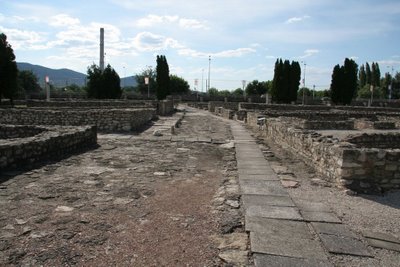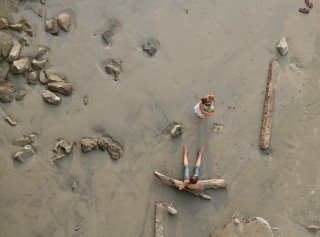As I promised earlier here are some more photos from the ruins of Aquincum.

First of all is the map of the excavation site and what is what in the ruins. Shop streets, public baths, forum, court of law and such. It was actually quite surprising how many baths this small area had. And yet the romans were not the people who brought the bath culture to Hungary, it was the ottoman turks, if I remember correctly that is. Please do rectify me if I am mistaken.

And now to the ruins themselves. This time we went to the excavation site itself to take a closer look of the ruins.
The area itself seems a bit too small for 40000 or so people, but then again the town of Aquincum streched on a far wider area than has been excavated. According to a guidebook of mine there are more ruins of the civilian town a kilometer or two to the south from these ruins. Although I don't know if the town itself was couple of kilometers in diameter I wouldn't think it to be impossible either.
The picture here, taken from a shadow of a column, displays part of the law-court building (basilika).

And here are the ruined remains of the so-called Butcher's house. It does take some imagination to see about anything supporting of any functionality for this ruined building but I trust the archeologists have made, at least, well educated guesses. I am not quite sure but I preume that the different coloured sand indicates what part of the ruins have been at one time the indoors (the red) and what has been outdoors (the white). It seemed pretty reasonable almost throughout the whole excavation but on some areas there was only white sand around the ruins.

Here on the far left side of the picture can be seen what remains of the north-south main road (cardo) and row of shops alongside it. right of the column are artisan societies' (collegii) headquarters in the front and artisans' houses further back. Even further back are the ruins of market-place and behind those are the ruins of the great public bath in the center of town.

Then follows a picture taken towards the place the previous picture was taken. This is the so colled E street. On the right side is the so-called merchant's house and on the left side of the street are some residental buildings with gardens.

And here is one of my personal favourites. Ruins of a large residental building with colonnaded central courtyard (peristylium). I can only imagine how beautiful that courtyard might have been "back then" in the roman days. Even ruined it looks peaceful and serene and made me want to just go there and relax. I could almost see and hear the flowing water in the fountain.

Amongst the ruins were, as I mentioned earlier, a few bath houses. In one of them the pool was quite clearly visible after all these years. When I was there I could imagine roman people taking a bath here. Someone stepping down the steps to the pool and other sitting on the edge of the pool one leg in the water. When looking at this picture I still can see them but I don't know just how the image relays through the picture.

Then this here picture is taken from the northeastern corner of the excavation site. The ruins are yet again of a bath house, public bath. If the shapes of the ruins in the other buildings tell anything then the semicircular shaped parts of the ruins are where the cold, hot and lukewarm pools were. The ruins have not been dug out completely, as you can see, because just outside of the right side of the picture is a paved road. Not heavily used but obstacle to the excavation anyways.

And then some examples of roman engineering. Here are the remains of underfloor heating. This kind of constucting was used in the bath houses to warm th water in the pools and steam rooms. Some more information about this can be found in
Wikipedia under the topic of
caldarium. Basicly the construction circulated hot air under the pool and warmed the water in the pool or in the case of the steamroom it evaporated the water to make the steam that heated the steamroom.

And last but not least, the
aqueduct. While not quite as grand as in the wikipedia entry, pretty amazing still. It was rather tricky to get here, next to the aqueduct, since it is located between an eight laned highway. Outside the excavation site there is a pedastrian crossing leading to virtualy nowhere. Except between the roads where this bit of the aqueduct is located.

This picture here gives a little better idea of how the aqueduct bits are located. This bit here is not the same as the one in the previous picture, as you propably had already guessed. Here in Budapest are more of these ruins among modern stuctures, freeways, apartment buildings and such. Luckily enough some of those have remained to this day.
 Have you ever had an irresistable urge to just yell to somebody you most definitely do not know, just to get their attention and no other reason?
Have you ever had an irresistable urge to just yell to somebody you most definitely do not know, just to get their attention and no other reason?





















